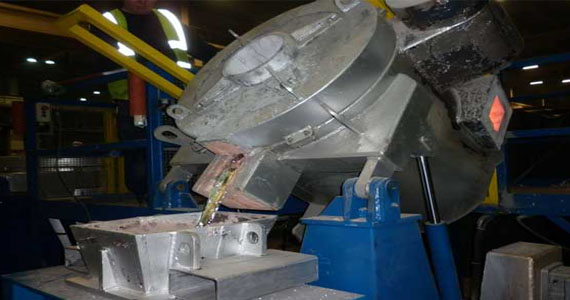
METAL SMELTING
CRUCIBLE TILTING FURNACE
Capacity range is 100 to 1000 Kg Brass / Gunmetal and 30 to 300 kg Aluminium per batch. Due to burner flame not coming in contact with the metal in the crucible, high purity metal and its alloys are suitable for melting in this furnace. These furnaces have central axis manual tilting arrangement with gear mechanism for pouring metal into the ladle. A motorized tilting version with inching facility is also available.
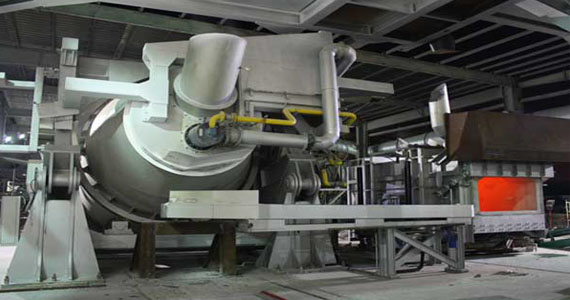
TILTING ROTARY FURNACES
The high performance tilting rotary furnace range from Melting Solutions produce the most effective melting furnace technology available in the market for processing mixed scrap and drosses. It is able to process many types of scrap including:
The tilting rotary furnace range combines advanced melting technology, process control and high quality engineering. It is aimed primarily at recycling applications. The advantages and flexibility of the tilting rotary furnace continues to deliver savings and efficiencies throughout the aluminum processing industry.
It delivers outstanding energy savings and increases productivity as a bulk melter for die-casting applications. For melting mixed, contaminated scrap including oxidised materials such as dross, the combination of low energy, high metal recovery and flexibility of feedstock, have shown the tilting rotary furnace to be a class leader.
Comparing the tilting rotary furnace range to other traditional rotary and fuel fired reverberatory furnaces shows significant savings:
Advantages of our Tilting Rotary Furnaces:
The latest tilting rotary furnaces also deliver savings and efficiencies by using a proven innovative design backed by in-depth process knowledge. They are offered with the following:
- Choice of fuels to suit local conditions, oil, gas, if available, with or without oxygen (oxy-fuel).
- Double pass burner firing with 'proportionator' combustion system to meter and mix the precise ratio of fuel (carbon) to oxidant (air or oxygen).
- Proportionator - accurate real time ratio control gives maximum fuel efficiency and process control. For example to 'oxidize' smoke during the start of a charge or to fire with 'reducing' atmosphere and save metal oxidation.
- Unique door arrangement, enabling the furnace to tilt and fire simultaneously. This gives better mixing of the charge, faster melting and higher metal recovery.
- Fast charging of all types of scrap, even oversize bulky materials, door openings available up to 79" internal diameter. Fully integrated charging machines. Fast charging means faster melting, less energy and more production.
- Variable melting angles. The tilt rotary door design enables the furnace body to be reclined to maximize load capacity.
All of the furnace controls and functions are controlled using the latest PLC and SCADA software. These are then communicated to the operator by a full size color HMI (Human Machine Interface) monitor. SCADA control is offered as an option. The data communicated to the central PLC from the various furnace sensors is displayed and stored. Data includes energy consumption, process temperatures and melt results etc. These are then available to print and transmit via ethernet or wireless applications to remote locations. The tilt rotary range is available in a number of standard capacities from 1 - 23 ton.
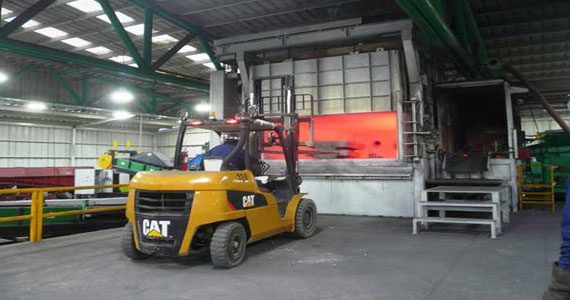
MELTING FURNACES
To succeed in secondary aluminum processing cost effective melting is essential. This means using the most energy efficient melting furnaces and highest level of automation to reduce labor costs. Most importantly though is the need to gain the highest metal recovery.
Our range of gas and oil fired melting furnace includes:
- Reverberatory melting furnaces with extended charging slopes stationary or tilting
- Twin chamber melting furnaces with a variety of metal circulation systems
- Sweat furnaces, with special dry hearths for separation of iron inserts in scrap
- Side well furnaces - classic designs with external side wells for melting of thin gage scrap such as swarf, turnings and chips
- Crucible melting furnaces for use in foundries and die casters
- Rotary furnaces for all types of scrap and particularly for dross processing
The selection of the correct furnace to melt specific scrap requirements is the key. Melting Solutions not only build all types of melting furnaces but can offer advice to select the correct furnace. This is then backed by the long practical experience of our team.
Characteristics of our advanced melting furnaces include:
- Full size doors to enable fast charging and access to the furnace.
- Door surrounds protected with heat resistant cast plates to protect refractories and ensure a lasting door seal.
- With high melt rates and high power inputs burner systems are selected to re-use waste heat from flue gasses by recuperative and regenerative burners. Oxy fuel alternatives are also available.
- Non contact bottom or side induction stirrers for improved metal circulation and unrivalled melt homogeneity.
- External charge wells either side, closed or EMP systems available according to scrap type.
- Refractory linings with high thermal insulation and chemical resistance to corundum formation.
- Accurate pressure control using high temperature flue dampers operated from sensitive pressure transducers.
- Correctly designed furnace geometry to allow easy cleaning of furnace slopes.
- Optimized burner positions and door sizes.
- Doors supplied with clamping mechanisms and seals to conserve energy.
- Models available with ceramic diffusers (porous plugs) embedded in the hearth for injection of nitrogen, argon and gas mixtures containing chloride.
- Including extraction hoods and furnace flue arranged on tilt axis 'knuckle joints' for ease of duct connections.
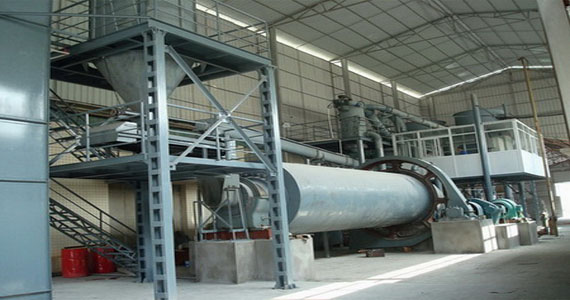
Ball Mill Type Oxide Manufacturing Systems
Operation
Lead Ingots are melted in the Melting Pot. The Molten Lead in the Melting Pot is pumped on to the Cylinder casting Machine. The Lead cylinders are casted in the Cylinder casting machines at a rate higher than that of the oxidation process. These Lead cylinders are conveyed and stored in a Silo.
The Silo feeds the required amount of Lead Cylinders into the Mill as and when required. The amount of Lead Cylinders being discharged from the Silo is adjustable from the PLC system. Lead Cylinders tumbling inside the Ball Mill drum create heat due to friction between them. This heat initiates the oxidation process. The oxidation process is also an exothermic reaction. This exothermic heat raises the temperature of the material which in tam accelerates the oxidation process. A draft of air through the Ball Mill drum gives oxygen for the oxidation process and also carries the Battery Oxide to the collection system.
The Collection System includes a combination of cyclone and dust collector or just dust collector. Battery oxide is collected and conveyed to storage silos. The Silos storing Battery Oxide are purged with Nitrogen to keep the temperature of the Oxide in check.
Reaction temperature :
Reaction temperature is monitored using thermocouples and is controlled by periodic water cooling.
Load in the Ball Mill :
The Load in the Ball Mill can be monitored by Load cells or by current consumption . According to the load in the mill, new material is fed automatically when the load reduces.
System Draft :
The System draft or air flow through the ball Mill is very precisely controlled and monitored. Te air flow volume is controlled by a motorized butterfly valve and te correspondin static pressure is monitored by pressure sensors.
Process Control
- Fully Automatic with PLC based Control system
- Totally Enclosed System
- Touch Screen Based Interface
- One Button Start / Stop
- 24 Hour Operation
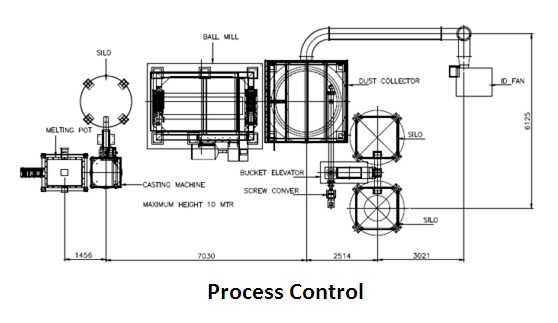
Litharage Specification :
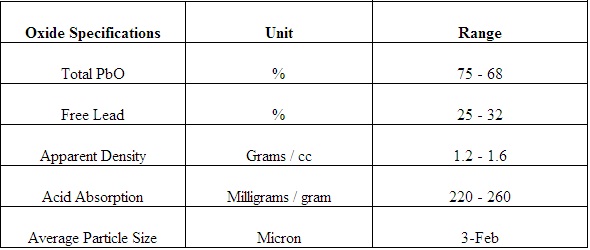
Production Rate :
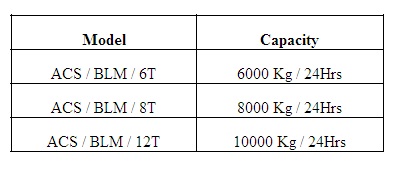
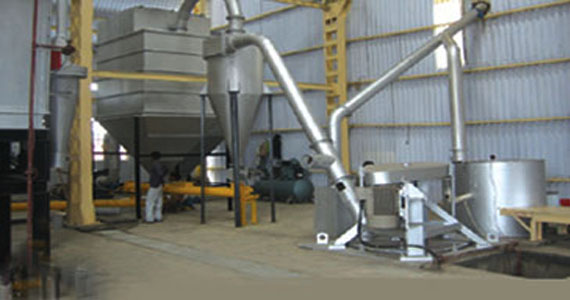
Barton's Pot Type Lead Sub Oxide Systems
Lead is melted in a Melting Pot and is pumped into the Reaction pot, where the exothermic reaction of converting Lead to Lead Oxide takes place. The reaction temperature and reaction ampere is controlled to achieve stable reaction and desired quality. Native pressure is maintained in the reactor. Oxide is removed from to reactor by suck in fresh air through it. Oxide is collected in the cyclone and to Dust collector.
The dust collector fitted wit PP coated filter base, filters the air and leaves fresh air to te atmosphere. Te exhaust air from the Dust collector meets the environmental emission standards.HEPA filters can also be used after the Dust collector.
Reaction temperature :
Reaction temperature is controlled by controlling the feed to the reaction pot and the amount of air sucked through the reactor. Water can also be used the control the temperature.
Reaction load :
Reaction load i.e ampere of te reactor is controlled by controllin the amount of lead entering the reactor.
System Draft :
System Draft is measured and controlled by a motorized butterfly Damper, through the control panel.
Other Features
- Fully Automatic with PLC based Control system
- Totally Enclosed System
- Touch Screen Based Interface
- One Button Start / Stop
- 24 Hour Operation
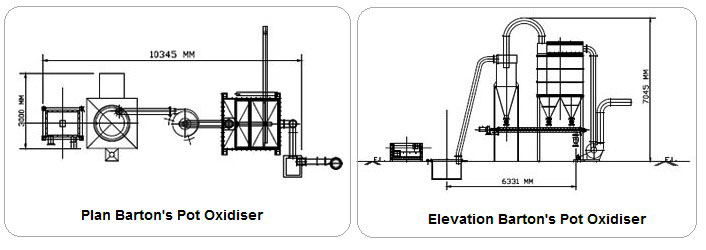
Specification of the Output ( Lead Oxide ) :
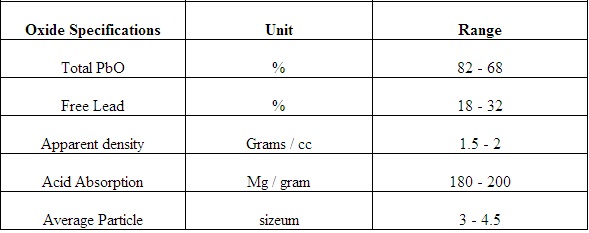
Production Rate :
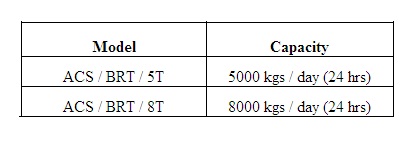

Litharge Manufacturing Plants
Litharge manufactured on ACS Litharge furnaces is suitable for use in Stabilizers, Batteries, Glass, Ceramics and specialty chemicals. The feed material to the litharge furnace is the output from the Barton Oxide System.
Operation
Litharge manufacturing is a batch process. The Furnace is pre-heated to 575-600°C by a gas/oil fired burner. Lead Oxide is metered and fed into the furnace. The material is mixed and agitated inside the furnace. The temperature is maintained between 575-600 °C throughout the reaction. The reaction is exothermic, hence less fuel is used to maintain the temperature. During the reaction negative draft is maintained inside the furnace. The air sucked passes through a bag house before being let into the atmosphere. The negative draft also helps in supplying fresh oxygen to the furnace. This ensures litharge with less than 0.05% of metallic lead.
Litharge from the furnace is fed to a crusher to break the agglomerates. This crushing takes place at 600 °C. After crushing, the litharge is stored in silos with cooling arrangement.
Reaction Control :Temperature
Temperature in the furnace is sensed by thermocouples and accordingly, and the burner is put ON/OFF.
Other Features
- Fully Automatic with PLC based Control system
- Totally Enclosed System
- Touch Screen Based Interface
- One Button Start / Stop
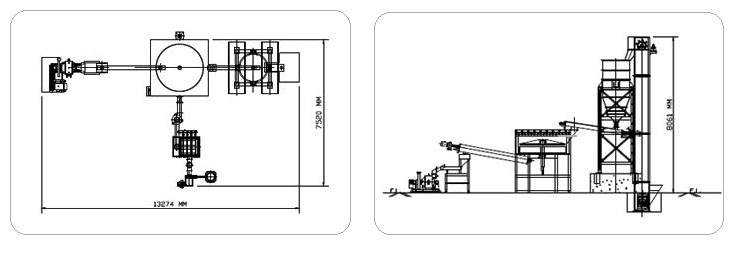
Litharge Specification ::

Production Rate :
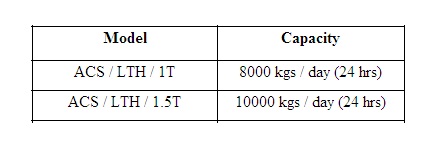
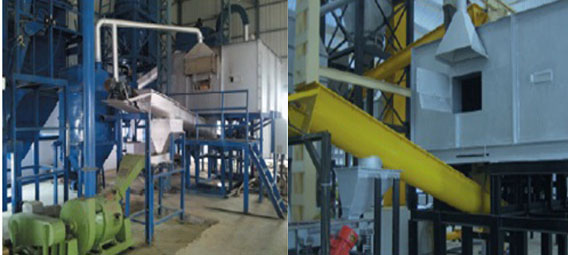
Red Lead Manufacturing Plants
Litharge manufactured on ACS Litharge furnaces is suitable for use in Stabilizers, Batteries, Glass, Ceramics and specialty chemicals. The feed material to the litharge furnace is the output from the Barton Oxide System.
Operation
Red Lead Furnace is a refractory lined oven. It is a batch process. The Lead oxide is heated and maintained at 450-500 deg Celsius till the conversion from PbO to Pb304 is complete. Ideally this conversion takes 20-24 hrs.
The production rate depends on the free lead in the input lead oxide. Lower the free lead in input oxide,faster will be the Red Lead Batches.
Gas or Oil fired burner is used to maintain the temperature of the Furnace. Thermocouples record the temperature inside the furnace, thus putting off the burners when not needed and hance saving energy.
The furnace is kept in negative pressure and the combustion air of the burner is filtered and left in to the atmosphere. The furnace is fed by as crew conveyor from Load cell mounted Silo. The silo uses vibrators to feed the oxide to the conveyor.
Other Features
- Fully Automatic with PLC based Control system
- Totally Enclosed System
- Touch Screen Based Interface
- One Button Start / Stop
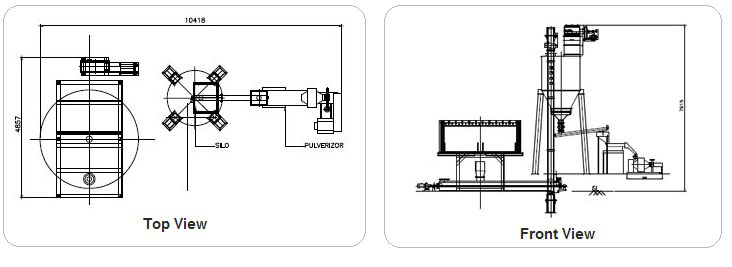
Production Rate :

Smelting and Refining
Smelting
In Smelting process metallic Lead is obtained in Short Rotary Furnaces at temperatures varying from 1000°C to 1400°C. This process is a batch process, in which the Lead Scrap is fed in Batches to the Rotary Furnace. The reduction reaction is carried out in the Rotary furnace.
The cycle time per batch is very critical for obtaining the maximum capacity.
To expedite the furnace charging operation , any one of the following equipments are used:-
The rotary furnace is Charged with :-
- Vibratory feeders
- Pushers
- Screw conveyors
The Smelted Lead from the furnace is then collected into Bullion Moulds, mounted on automated trolleys.
Gas/ Oil burners can be used for the smelting operation. Oxy-Fuel burners can be used for Rotary Furnaces of Higher capacities.
The pollution control system consists of settling chamber ,cyclone , cooling ducts , spark arrestor , bag filter , wet scrubber and chimney. The temperature of gases is measured at various points.
We have successfully manufactured and supplied Rotary Furnaces from Batch Size 2 MT to 20 MT.
Refining
Refining operation is a Pyrometallurgical process, carried out in kettles of capacities of 25 MT or 40 MT. Metals like copper, tin, arsenic and bismuth are removed from the hard Lead to manufacture pure Lead. Purity of Lead achieved is 99.97 %( Min).
TLead alloys, needed in Battery Industry are also manufactured in the Kettles.
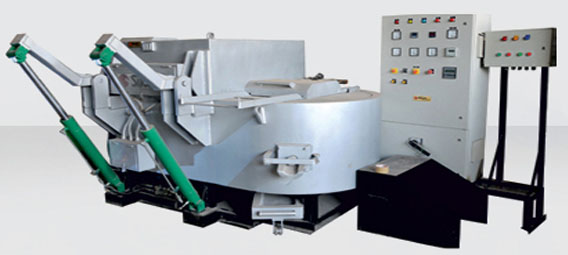
IMMERSION BURNER SYSYTEMS
Burns Energy Systems can supply Immersion Burners and Immersion Burner Systems suitable for your non-ferrous melting application.
Immersion burners feature self-recuperative burner heads mounted inside closed-ended silicon carbide tubes. Hot gases from inside the immersion tube are caused to exit though the burner head via an integral heat exchanger.
In operation the silicon carbide tube is immersed in a molten bath of zinc or aluminum alloy. As most of the heat transfer happens below the surface of the molten metal bath, the immersion burner system offers excellent efficiency and production rates in comparison with other heating technologies.
Immersion burners are best suited for aluminum and zinc alloy die cast applications and for special coating applications such as Galfan, Galvalum, Aluminum, and Galvanize.
The main advantages of the immersion burner system over other technologies such as the immersed crucible furnace or the reverberatory furnace are:
- Low inclusion count
- Low fuel cost
- Higher efficiency
- Effective convective mixing of the alloy
- Accurate temperature control
- Minimum maintenance and downtime
Furnaces designed around the Immersion Burner System typically feature ceramic linings with excellent service life. In addition, the refractory in contact with the alloy is not prone to dissolving and the consequent contamination of the molten alloy.
Burner systems are highly modular in construction and feature accurate gas-to-air ratio control and reliable operation. Safety systems and devices are in accordance with your local gas safety code. Our systems have been installed and are in operation world wide.
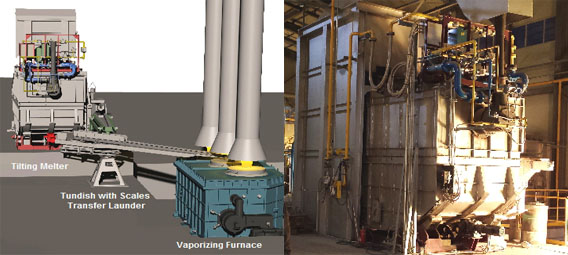
HIGH EFFICIENCY ZINC MELTING (TILTING) FURNACE
The Burns Energy Systems Zinc Melting furnace has been designed to be easy to operate and maintain. Its purpose is to efficiently pre-melt SHG (Special High Grade) zinc, or to remove iron from zinc dross (top and/or bottom) prior to transfer to the vaporizer. The furnace produces a consistent quality melt with low heat losses and low unit production cost.
This innovative melter is designed as a tilter and therefore a metal pump is not needed for furnace discharge. The tilt mechanism is actuated by a 3.5 kW (5 hp) electric motor and a curved rack and pinion drive. The heating system features energy efficient Recuperative Burner Technology providing excellent operational efficiency and excellent pollution control to minimize CO2 and NOx.
This furnace can be easily integrated with Burns Energy Systems Launderand Tundish system and can be supplied with an optional weight scale for accurate metal transfer accounting.
The melter has been designed to operate with liquid zinc in contact with the furnace refractory lining. The reverse tilt is designed to assist the operator during ash removal and ingot loading. Ash is drained on the exposed sloping hearth before being removed from the furnace. To recover zinc from the precipitate it must be mechanically pressed to break up encapsulated zinc.
The control system has been designed to store operational data at a secure remote location via a system PLC, Ethernet link, system web addresses or a secure link to a network hub. Safety systems are in accordance with EN 746.2 Fuel Gas Safety Code. NFPA, CSA, and other codes available on request.
Features of Zinc Melting Furnace:
- Easy to maintain
- Excellent temperature uniformity
- Preheating shelf for easy loading
- Loading by Lift truck or overhead crane
- Hydraulic actuated access door
- Reverse tilt for cleaning and de-ashing
- Smooth flow tilting discharge
- No ceramic pump for metal transfer
- Electric high torque actuator to control furnace tilt
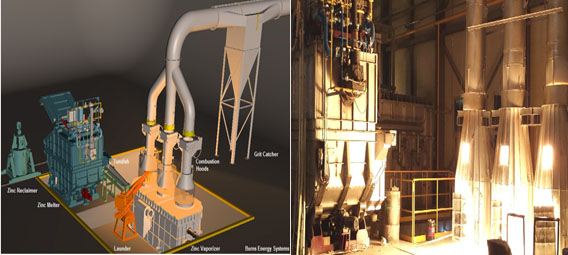
HIGH EFFICIENCY ZINC MELTING AND VAPORIZING FURNACES
Burns Energy Systems uses two furnaces as part of our zinc vaporizing process. Both furnaces feature revolutionary designs which have been optimized using extensive CFD studies and practical field experience.
- High Efficiency 3-Crucible Vertical Vaporizing Furnace
- High Efficiency 2-Retort Horizontal Vaporizing Furnace
The Vaporizing furnace utilizes two Regenerative burners with combustion efficiencies as high as 85%. The result is zinc vaporizing at less than 3GJ/tonne with a 24 tonne ZnO/day maximum production rate per furnace (with new crucibles). The production rate decreases to approximately 20 tonnes ZnO/day as the crucibles age.
The Zinc Melting furnace features recuperative burner technology. The combustion efficiency is 62% and the overall melting cost is <0.7 GJ/tonne.>The tilting feature of the melter eliminates the need for a zinc pump or ladle to discharge liquid zinc, making the system simple to operate. The tilting melter may also be used to recover low iron zinc from top and bottom dross.
Typical combustion efficiency for burners without heat recovery features is approximately 35%-40%, making the Burns Energy Systems furnaces 2 to 3 times more energy efficient than the industry norm.
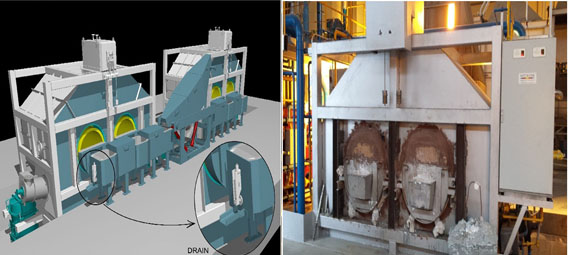
HIGH EFFICIENCY 2-RETORT HORIZONTAL VAPORIZING FURNACE
The twin retort furnace has been developed to process top and bottom dross from galvanizing and die-casting operations also known as secondary zinc. This furnace is specifically designed for users who wish to process high lead content Bottom Dross. As lead is not removed in the Dross Recovery Furnace (DRF), any lead in the feed to the DRF will be present in the vaporizing furnace and will accumulate over time. This will result in Lead being present in the zinc dust or the zinc oxide in proportion to its partial pressure in the zinc vapour, which in turn will be in proportion to the quantity of lead in the retort.
To reduce lead in the product it is necessary to remove lead from the retort and this process is significantly easier with the horizontal design than the vertical crucible vaporizer. This furnace has been designed to simplify the process of lead removal making the high Lead feed materials a more attractive feed option for your process. In actual operation, the lead levels in the product will be monitored and when the lead needs to be removed the furnace is taken off the boil. The residual zinc in the retort is drained, either using a drain plug in the retort cover or by removing the drain in the feed launder as shown in the graphic below.
The metal is drained into a travelling ladle where it is cooled. As the ladle cools the solubility of lead in zinc decreases and the lead separates and collects in the bottom. The zinc collects on the top of the lead and may be removed after it has frozen, usually before the lead freezes. The recovered zinc has a lead content of about 1.2% and is returned to the process. Lead that collects in the bottom of the ladle can be cast into ingots and is a salable grade material with about 1.2% zinc still in solution.
The retort is immediately put back into production after draining by transferring new metal from the melting furnace.
The Twin retort furnace has the same burner system as the high efficiency 3-crucible vaporizing furnace and is capable of firing under sub-stiochemtric conditions as well as oxidizing conditions. This is important as Burns Energy Systems has been working with the refractory suppliers to perfect a system of body and glaze that resists the oxidation of the retort under varying furnace conditions. This results in a longer retort life in service and more importantly a greater production yield per retort.
The furnace is rated at a nominal 10 tonnes (ZnO) production per day with a fuel consumption rate of about 3.2 GJ/t depending on the production rate and the life of the retort.
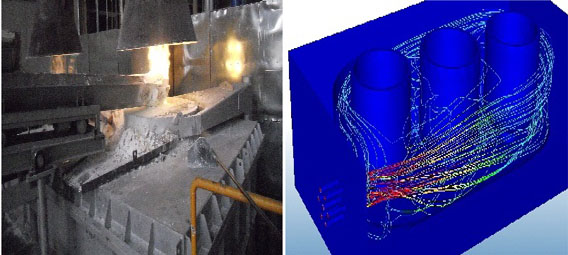
HIGH EFFICIENCY 3-CRUCIBLE ZINC VAPORIZING FURNACE
Burns Energy Systems furnaces use 3 large crucibles to provide a high production capacity with a small footprint and reduced material losses.In addition, crucible loading has been simplified to make the process of crucible changes quick and easy.
This furnace has been designed to fire in sub-stoichiometric mode as an option. This produces a protective gas atmosphere which helps protect the graphite in the body of the crucibles making them last longer. The Post Combustion option recovers energy from the vented gas atmosphere, ensuring only CO2 is vented from the furnace and all energy is recovered from the fuel.
We use 3D modeling tools to help us design our industrial furnaces. We have used CFD techniques to examine the flow of air across the furnace top plates and crucible covers. We have been careful to make sure that the furnace top plate design provides a smooth air flow which minimizes Zinc Oxide losses.
Burns Energy Systems is pleased to announce the release of the third generation furnace for zinc vaporizing. Years of R&D and collaboration with ZnO industry experts, has produced our most efficient and reliable vaporizing furnace yet.
CFD technology (Computerized Fluid Dynamics) has been used extensively to optimize the furnace shape and burner layout to provide the most efficient crucible heating and greatest zinc temperature uniformity. Good temperature uniformity is crucial to ensure a consistent zinc boiling rate which leads to high quality product and excellent yield.
The exceptionally high energy efficiency of the vaporizing furnace is the result of a combination of factors such as using CFD to refine and optimize the furnace design, and liquid charging large crucibles to achieve economies of scale. The greatest benefit, however, comes from the use of regenerative burner technology which achieves 85% combustion efficiency in this application, while at the same time reducing CO2 and providing ultra low NOx levels. This third generation Burns Energy Systems vaporizing furnace is extremely fuel efficient requiring less than 3 GJ/tonne to produce ZnO. The system is very easy to maintain and operation by one person is possible.
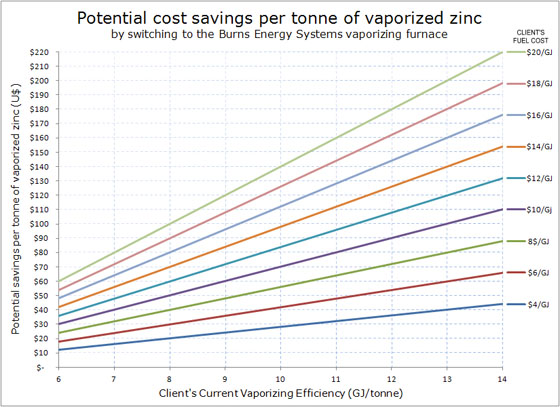
Zinc Vaporizing Furnace Production Capacity:
- Up to 275 kg/hr of zinc vaporized per crucible
- Liquid metal = 3,500-4,500 kg per crucible (x3~12,000kg)
- Nominal Furnace Production Rate 20-24 tonnes/day of ZnO
- Each vaporizer produces approximately 7,000 tonnes ZnO/year
- Zn : ZnO = 1 : 1.22 or better conversion rate using SHG
- Fuel consumption rate per tonne of ZnO produced
< 3 GJ/tonne or better
< 80 Nm3 of Natural Gas / tonne ZnO
Zinc Vaporizing Furnace Design features
- 3 isostatically pressed Clay-Graphite crucibles (or SiC)
- Gas or Propane burners (Light Fuel Oil optional).
- Manufactured in 2 halves for containerized shipping
- Pre-fabricated pipework panels
- Pre-wired assemblies wherever possible
- Pre-fabricated electrical control panels
Advantages of Burns Energy Zinc Vaporizing Furnace
- Easy to operate - single person
- Very efficient regenerative burner option
- Consistent boiling rate
- Liquid metal feed from Burns Energy Systems Melter
- Low maintenance
- Low CO2 emissions
- Ultra low NOx emissions
- High production rate capacity
- Compact
- Lead recovery option
- Long crucible life (3 to 4 months when used with SHG)
- Minimal time to change crucibles
- CFD refined furnace design
